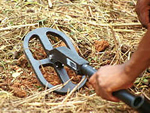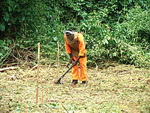Metal Detection

The metal detector gives out audible alerts when metal in the ground disturbs its artificially generated magnetic field. The detector heneedelad is panned slowly over the suspicious terrain.
A cool head and a steady arm
When the deminers enter an area that may be mined, their first task is to mark a line defining where the safe ground ends. When the marking is completed and start points determined, the metal detectors need to be calibrated for the ground conditions. Depending on the moistness or chemistry of the soil, the detector reacts differently. Only after the battery current is checked and the sensitivity of the device is manually adjusted with reference to small test pieces of metal, can searching begin.
Any undergrowth remaining at the start of the search lane is carefully cut and the metal detector is passed over the ground. This is a tiring task that demands the highest levels of concentration.
Quietly and without haste every square centimetre is scanned. A well trained deminer uses the audible alerts of a detector to tell exactly where metal objects are under the sensor ring. Every signal is carefully examined.
To examine a detector reading, the deminer uses a long, thin probe and sometimes a long-handled trowel. He uses the probe to feel under the ground for the side of the mine - always from the side and from a low angle.
The suspicious metal object must always be uncovered and removed. Almost every time it is merely a harmless piece of metal junk such as foil from a cigarette packet, a bottle top, a bullet casing or an unrecognised lump of rust. But every harmless piece of metal could be the trigger mechanism of a mine. You never know ...

Good training, strict safety measures and the best equipment makes the risk manageable...
Precisely regulated procedures minimize risk
In MgM, every little step of a deminer’s work is regulated by strict safety rules.
Working in two-man teams with a one-man drill, the second member of the team watches and corrects the actions of his partner from a safe distance of at least 25 meters. Every thirty minutes they change roles and the watcher becomes the watched. They change roles because no-one can concentrate for longer than 30 minutes and also to break the monotony of routine that could lead to a fatal mistake.
Until today only one accident has happened. In October 2088 one of our deminers showed a landmine he just found to another MgM worker after working hours - they didn't wear their safety wear. The landmine exploded and injured both of them in the face.
Still the risk remains. Care must be taken to avoid awareness of danger being replaced by a blindly followed, mechanical routine.





